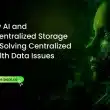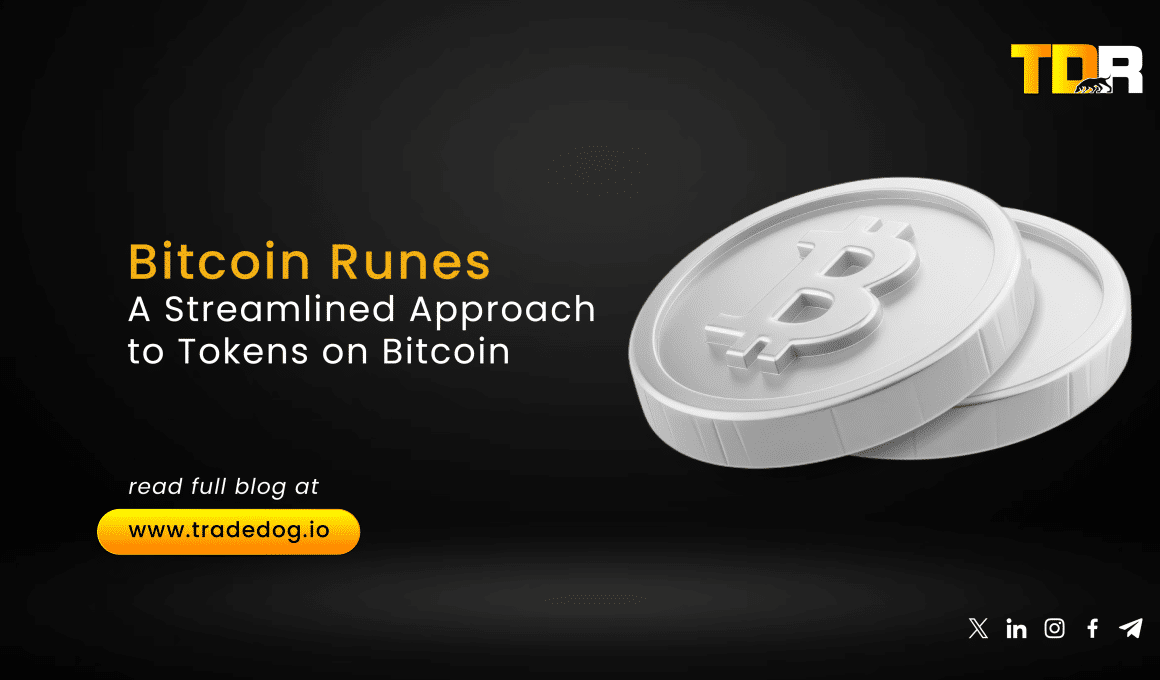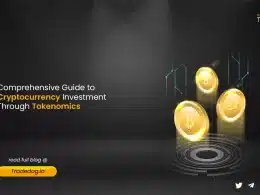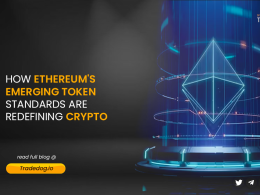Quick Links
The evolution of the Ordinals Theory by Casey Rodarmor back in 2022 led to the foundation for the issuance & trading of NFTs in the Bitcoin Ecosystem. Leveraging this theory, a pseudonymous creator named Domo developed the BRC-20 token standard in March 2023 which was quickly adopted by the Bitcoin community and has led to an MCap of over ~ $2.6 Tn. However, integrating these tokens within the Bitcoin blockchain has presented multiple challenges which Rodarmor aims to solve by introducing Runes Protocol.
In order to get a better understanding of what Runes brings to the ecosystem, let’s first understand the undesirable consequences associated with BRC-20 and other standards.
Quick Recap of Challenges in BRC-20 Standard
One major issue is their inefficient use of Unspent Transaction Outputs (UTXOs). UTXOs are units of Bitcoin that haven’t been spent yet. These protocols can create a large number of UTXOs per token, leading to network congestion. Additionally, scaling these solutions becomes difficult as the number of tokens increases.
Introduction to Runes Protocol
This is where Bitcoin Runes come into play. The launch of Bitcoin Runes was strategically timed to coincide with the Bitcoin halving event, on April 15th, 2024. Bitcoin Runes are fungible tokens native to the Bitcoin blockchain. This means they are digital assets existing directly on Bitcoin, readily transferable and interchangeable. They offer a fresh perspective on tokenization. This new protocol proposes a way to create fungible tokens directly on the Bitcoin blockchain but with a key difference: efficiency. It uses the existing UTXO model, a fundamental element of Bitcoin transactions. This allows them to seamlessly integrate with Bitcoin’s architecture without introducing drastic changes.
How does Runes manage these tokens efficiently? Here’s where the concept of Unspent Transaction Outputs (UTXOs) becomes crucial. Every Bitcoin transaction involves sending bitcoins from existing UTXOs (unspent outputs) to new UTXOs. Think of UTXOs as coins in your digital wallet. When you spend a portion of your bitcoins, a new UTXO is created with the remaining balance.
Here’s where Bitcoin Runes leverage UTXOs for efficient token management:
- A Single UTXO for Multiple Runes: Bitcoin Runes cleverly embeds metadata within a single UTXO. This metadata specifies the number of Rune tokens associated with that UTXO. In simpler terms, imagine a single coin in your wallet now holds information about how many Runes you possess.
- Efficient Tracking: Unlike other protocols that create a separate UTXO for each token unit, Runes keeps track of balances within a single UTXO. This significantly reduces the number of UTXOs created, minimizing network congestion.
- Seamless Transfers: When transferring Runes, the UTXO is “split” into new UTXOs, each containing the designated amount of Runes for the recipient. This process ensures secure and efficient token movement on the Bitcoin blockchain.
How does Runes Work
Runes Protocol is built around Runes, which are basic units that represent fungible tokens. Unlike Ethereum’s ERC-20 standard, Runes is native to the Bitcoin UTXO model. Each Rune has a unique ID that carries information about its current output and amount.
Here are the key concepts:
UTXO Model: Unlike Ethereum’s account-based system, Bitcoin uses Unspent Transaction Outputs (UTXOs). Each transaction output represents unspent Bitcoin that can be used as input for a new transaction. Runes uses this model to embed data about token creation and transfers directly within Bitcoin transactions.
OP_RETURN: Runes uses OP_RETURN, a Bitcoin opcode that allows data to be embedded within a transaction without affecting its validity. This data, limited to 80 bytes, carries information about token creation (etching), transfer, and other functionalities. Unlike regular Bitcoin transactions where you send coins, OP_RETURN is used to attach extra information. The coins in this output can’t be spent like usual. Developers use OP_RETURN for various purposes like timestamping documents, storing small bits of game data, embedding messages for fun, and creating tokens on Bitcoin (like with Runes Protocol).
Runestones: Messages encoded within transactions using OP_RETURN are called Runestones. These messages contain details about the specific actions being performed with a Rune token, such as creating new units, transferring existing ones, or destroying them. Runestones come in three types:
- Etching: Defines the genesis of a new Rune token. Includes parameters like token name, symbol, divisibility, and initial supply.
- Transfer: Facilitates the transfer of Runes from inputs to outputs within a transaction. This Runestone carries the Rune ID, output number, and the amount to be transferred.
- Burn: Intentionally destroys a specified amount of Runes. This serves to control the token supply and can be useful for various applications.
Runes Protocol Flow
Creating a Rune (Etching Process)
“Etching” is the process of creating a token in the Runes protocol. It involves creating a Bitcoin transaction with a special Runestone message encoded using the OP_RETURN opcode. This Runestone acts like a birth certificate for your token, specifying its unique name, recognizable symbol, divisibility, and initial supply. Once miners validate the transaction containing the etching Runestone, your new Rune token is born and resides within the designated output of the transaction. The etching process also allows for pre-mining, where a preset amount of the Runes being created are allotted to specific wallets before they are minted.
Transferring Runes
The Runes Protocol enables the transfer of newly etched Runes through a specialized Runestone, known as the transfer Runestone. This message, embedded within a new Bitcoin transaction, outlines the specifics of the transfer, including the Rune’s identity, current location, new destination, and the amount being transferred. Once miners validate this transaction, the designated amount of Runes moves from the current output to the new one.
Validating Runes & Role of Cenotaphs
Miners and nodes across the Bitcoin network act as gatekeepers, validating each transaction containing Runestones. They ensure that Runes aren’t duplicated, destroyed unexpectedly, or moved contrary to the instructions in the transfer Runestone. If there’s a mistake in a Runestone, the transaction gets flagged as invalid. This is where “Cenotaphs” come in. Transactions with Cenotaphs are “burned,” meaning the Runes within are effectively destroyed. This mechanism encourages users to be careful with their Runes, promoting responsible participation in the ecosystem.
Key Statistics
- Transaction Volume: The daily transaction volume has seen a significant drop from an average of ~ 3K in April to just 225 in June. Similarly, the average daily transactions of Runes have dropped from around ~ 600K in April to ~ 280K in June. This indicates a decrease in user activity or a shift in user behavior.
- Total Transactions: The total number of transactions stands at ~ 10.78 Mn as at the date of writing. The most common transaction types were mints (6.47 Mn) and edicts (4.23 Mn), followed by transfers and etchings (78K). This is an indicator that users are more engaged in creating new tokens (mints) and performing specific actions with tokens (edicts) rather than transferring or creating new types of tokens (etchings).
- User Base: The protocol has a cumulative user base of ~ 5.7 Mn, with 2.5 million new users added in the last 30 days. This is a healthy sign of growth and adoption. However, the drop in daily transactions suggests that while the user base is growing, activity per user is decreasing.
Potential Challenges Impacting Runes Adoption
While Bitcoin Runes offer a promising approach to tokenization on Bitcoin, it’s important to acknowledge some key points:
- Nascent Stage: Bitcoin Runes are a relatively new technology. While the concept holds significant potential, the real-world applications and user base are still evolving.
- Compatibility: As a new protocol, ensuring seamless integration with existing Bitcoin infrastructure is crucial for wider adoption. Compatibility with wallets, exchanges, and other Bitcoin-based services will be essential for Runes to gain traction.
- Data Storage Debate: The ongoing debate regarding data storage on the Bitcoin blockchain has implications for Runes. OP_RETURN outputs, used by Runes for protocol messages, contribute to the data stored on the blockchain which raises concerns about potential scalability issues in the long run.
Closing Thoughts
Bitcoin Runes have the potential to significantly enhance Bitcoin’s capabilities as a platform for token creation. Their efficient UTXO-based approach offers a more scalable and secure solution compared to existing methods. This could pave the way for a wider range of tokens to be built directly on the Bitcoin blockchain, potentially attracting new users and applications to the ecosystem.
Wider adoption of Runes will likely depend on key factors like ensuring smooth integration with existing Bitcoin infrastructure like wallets and exchanges. Additionally, the ongoing development of the protocol and its ability to adapt to future needs will play a significant role. If these challenges can be addressed, Bitcoin Runes have the potential to become a game-changer for tokenization on Bitcoin, fostering a more vibrant and diverse ecosystem.









